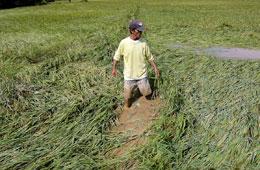Duterte blames US, rivals for soaring food prices

Food prices are soaring in the Philippines as the Philippine Statistics Authority announced inflation for August hit 6.4 percent year-on-year, the highest in nine years.
Experts are predicting a seven percent inflation in the Philippines could be around the corner in the wake of Super Typhoon Mangkhut, which battered northern Philippines.
More than half a million metric tons of paddy rice were wiped out by Super Typhoon Mangkhut, adding pressure to rice prices which are already at a record.
Michael Enriquez, chief investment officer at Sun Life of Canada Philippines, forecast inflation of as high as 7 percent in September, from 6.4 percent last month, which was the fastest pace since 2009.
“There’s a strong possibility inflation will hit that high,” Enriquez said. “Even before the storm, prices have been moving higher, especially for rice and oil.”
The typhoon couldn’t have come at a worse time for the Philippines, with soaring inflation and a currency slump of more than 7 percent against the dollar this year prompting the central bank to hike interest rates by 100 basis points since May.
Pressure started at the beginning of the year with higher oil prices and tax increases on fuel and quickly moved to rice because of supply shortages. Rice is the staple food in the country and is the second-largest item in the consumer basket.
The agriculture department estimated that 558,441 metric tons or 11.45 billion pesos ($212 million) worth of rice ready for harvest have been lost, while other crops like corn were also destroyed.
ING Groep NV warned that rice prices, which have risen more than 20 percent this year, will soar even more. Inflation may be higher than 6.5 percent in September, Nicholas Mapa, a senior economist said. The September data is scheduled to be released Oct. 5.
Government officials are rushing to implement measures which include easing importation of rice and sugar, but the impact on prices may only start after October, Sun Life’s Enriquez said.
The typhoon’s blow on food supply is happening at a time when oil is anticipated to go up and inflation pressure will probably last even beyond September, said Rachelle Cruz, an analyst at AP Securities Inc. in Manila.
When Rodrigo Duterte became president two years ago, inflation for July 2016 was just 1.9 percent. Prices of alcoholic drinks and tobacco climbed 21.6 percent in August from a year ago, while food and non-alcoholic drinks rose 8.5 percent.
The average retail price of regular milled rice was 45.27 peso per kilogram in the first week of September, an increase of 19 percent from a year ago.
The peso slumped to a 13-year low of 54.28 to the US dollar on September 17, bumping up the cost of imported food ingredients. He has tried to replace these ingredients with cheaper local products, but some imported items must be kept to maintain the “integrity” of the dishes.
This month, Duterte blamed the US President Donald Trump and the trade war with China for the inflation that has hit the Philippines.
“Who started it? America!” Duterte said. “When America raised [tariff] rates and interest rates, everything went up.”
But his views differ from the central bank, which said inflation was partly the result of higher excise taxes imposed by the government that has driven up food, alcohol and tobacco prices.
Inflation in the Philippines is now the second highest among Asean (Association of Southeast Asian) countries, only lagging Myanmar’s 7.56 percent. According to the latest figures, inflation is 4.5 percent in Vietnam, 3.2 percent in Indonesia, 1.6 percent in Thailand, 0.9 percent in Malaysia and 0.6 percent in Singapore.
To rein it in, the Philippine government’s economic managers plan to submit a draft executive order to Duterte to simplify the process of food imports.
The firebrand leader has accused his political opponents of using inflation to turn the public against him. He said the Communist Party of the Philippines and Senator Antonio Trillanes were plotting to overthrow him.
Duterte has ordered the arrest of Trillanes, after revoking an amnesty provided to the senator after his involvement in the failed 2003 and 2007 coup attempts against a former president, Gloria Arroyo.
But even if Duterte was right about a plot to oust him, the question is whether the public discontent caused by inflation is bad enough for that plot to work.
The Philippines has struggled with high inflation before. It reached a peak of 50.3 percent in 1984, during the time of dictator Ferdinand Marcos; was at 19 percent in 1991, partly fuelled by the Mount Pinatubo eruption; and was about 9 percent in both 1998 and 2008.






